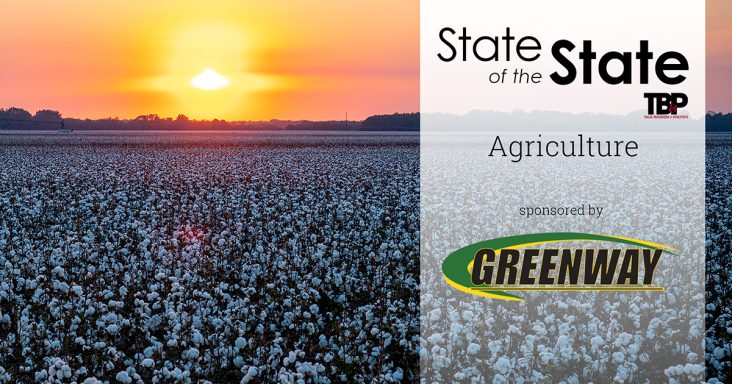State of the State Mid-Year 2023: Cattle, crops face another turbulent year
by August 9, 2023 3:57 pm 752 views

Editor’s note: The State of the State series provides reports twice a year on Arkansas’ key economic sectors. The series publishes stories to begin a year and stories in July/August to provide a broad mid-year update on the state’s economy. Link here for the State of the State page and previous stories.
Arkansas’ top agriculture sectors continue down a turbulent path as the second half of 2023 unfolds. Some crops such as rice and soybeans are faring better this year with prices and acres up or at least steady.
Other sectors including cattle and cotton are significantly down, while another sector, corn is up acreage wise but prices remain uncertain as global events such as the Russian invasion of Ukraine continue to make prices volatile.
One factor that impacted many crop and livestock farms in 2022 was the weather. A record-setting drought enveloped the entire state. One ag sector that was hit hard by the dry, hot conditions that persisted through most of the year was the cattle industry. Arkansas typically ranks among the top 15 beef cattle producing states. There were nearly 1 million head of beef cattle/cows in the state in 2020, the U.S. Department of Agriculture (USDA) reported. That number has dropped to about 10% to 905,000, according to the USDA’s latest cattle inventory reports.
Beef is typically the fifth largest agri sector in Arkansas. It’s a nearly $1 billion industry in the state with about 24,000 farms. Roughly, 5.6 million acres are utilized in the industry, according to the Arkansas Farm Bureau.
The beef cattle problem is not exclusive to the Natural State. USDA’s Cattle Inventory report, released in July, stated that the U.S. has record lows for cattle inventory. The U.S. cattle industry in aggregate has reduced its inventory by 3% to 95.9 million head, the lowest since 2014. The inventory of beef cows in particular fell to 29.4 million head, 3% lower than the January 2022 inventory and the lowest number on record since 1971, when USDA began collecting such data.
James Mitchell, extension livestock economist for the University of Arkansas System Division of Agriculture, said the overall decline in inventory was expected, propelled by the high cost of production and drought.
“It seems like every time drought abates in one part of the country, it pops up somewhere else,” Mitchell said. “Two years ago, we had a terrible drought in the western part of the country – Colorado, Montana, Wyoming. Last year that drought moved over the plains states, from North Dakota all the way down to Texas. Currently, that drought has moved either farther east, so it’s hitting Missouri and Iowa. It shifted east, and impacted producers’ ability to retain heifers and to grow their herds.”
Arkansas producers, while more or less in the same fight as everyone else, have at least managed to avoid the worst of the country’s drought effects this year, Mitchell said.
“Knock on wood, we’re pretty fortunate in the southeast right now, in that we have largely avoided multi-year long-term drought, while other parts of the country haven’t been so lucky,” he said.
While rising market prices will typically spur an increase in herd inventories – 2023 has seen remarkably high prices for beef, rising more than 25% above 2022 numbers – high input costs have largely undercut that impulse, Mitchell said.
“Higher prices generally mean that people should think about rebuilding their herds,” he said. “But we don’t make decisions based on prices, we make decisions based on profit. Currently, we’re seeing prices we haven’t seen since 2014, 2015. But then, those higher prices translated to higher profits, because we weren’t battling the high input cost situation that we are today. We’re not going to see the same rate of expansion that we saw 10 years ago, because the profits aren’t there. I think we’re going to see higher prices for a sustained period of time because nationally, the profits aren’t there for us to start building back herds.”
One crop that seems to be doing better this year is rice.
The USDA’s Natural Agricultural Statistical Service (NASS) projects that about 1.311 million acres of the crop have been planted in Arkansas. That’s nearly 200,000 more acres than were planted in 2022. Nationally, about 2.687 million acres have been planted, a nearly 400,000-acre uptick since the last growing season.
Despite higher prices overall this year, Arkansas soybean growers planted slightly fewer acres in 2023, with intended acreage falling 4% to just over 3 million acres. Nationally, acreage for the crop dropped from 2022 at 83.5 million acres. Arkansas corn farmers were projected at the start of the growing season to increase acreage by about 14%, going from 710,000 total acres in 2022 to 810,000 acres in 2023. This followed a national trend.
U.S. corn acreage rose 3.4% from February estimates, while soybean acres fell 4.6%. At 94 million acres, it’s the third largest corn crop, nationally, since 1944. After the report, prices rose for soybeans and sank for corn.
One staple row crop in Arkansas dropped significantly in 2023. Cotton planted acres are estimated at 11.1 million, down 19% from last year, nationally, NASS reported. Upland area is estimated at 11.0 million acres, down 19% from 2022. American Pima area is estimated at 109,000 acres, down 40% from 2022. In Arkansas, about 480,000 cotton acres have been planted, a drop of about 160,000 acres from last year. The Natural State ranks fourth in cotton production this year among all states, NASS reported.
